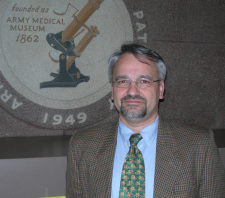Gastrointestinal Stromal Tumor Pathology and Prognosis
GSI asked questions about subtypes of gastrointestinal stromal tumor (GIST) and their malignant potential to Markku Miettinen, MD PhD and Jerzy Lasota, MD PhD. Drs. Miettinen and Lasota, of the Armed Forces Institute of Pathology, have published many papers about the largest existing series of GIST cases, grouped by anatomical location, as well as many mutation analyses.
 Dr. Markku Miettinen is chairman of Soft Tissue and Orthopedic Pathology in AFIP since 1996. From 1988-1996 he was with Jefferson Medical College Thomas Jefferson University in Philadelphia, PA, as an attending pathologist and a professor of Pathology, Anatomy and Cell Biology. He is originally from Helsinki, Finland where he also got his medical degree and completed his residency in pathology, and also served as an attending pathologist until 1988. He has approximately 300 scientific publications, over 30 on GISTs. He has published a book “Diagnostic Soft Tissue Pathology†in 2003.
Dr. Markku Miettinen is chairman of Soft Tissue and Orthopedic Pathology in AFIP since 1996. From 1988-1996 he was with Jefferson Medical College Thomas Jefferson University in Philadelphia, PA, as an attending pathologist and a professor of Pathology, Anatomy and Cell Biology. He is originally from Helsinki, Finland where he also got his medical degree and completed his residency in pathology, and also served as an attending pathologist until 1988. He has approximately 300 scientific publications, over 30 on GISTs. He has published a book “Diagnostic Soft Tissue Pathology†in 2003.
 Dr. Jerzy Lasota is a research pathologist in the Department of Soft Tissue Pathology of the AFIP, where he has worked since 1996. From 1989 to 1996 he was with Temple University’s Fels Institute for Cancer Research and with Jefferson Medical College of Thomas Jefferson University in Philadelphia, PA, as a research scientist and in the Molecular Diagnostic Laboratory. He is originally from Lodz, Poland, where he also completed his medical school and was certified as Anatomic Pathologist. He has approximately 100 scientific publications, over 30 on GISTs.
Dr. Jerzy Lasota is a research pathologist in the Department of Soft Tissue Pathology of the AFIP, where he has worked since 1996. From 1989 to 1996 he was with Temple University’s Fels Institute for Cancer Research and with Jefferson Medical College of Thomas Jefferson University in Philadelphia, PA, as a research scientist and in the Molecular Diagnostic Laboratory. He is originally from Lodz, Poland, where he also completed his medical school and was certified as Anatomic Pathologist. He has approximately 100 scientific publications, over 30 on GISTs.
Readers are encouraged to access the latest paper from these two illustrious GIST pathologists for more details beyond the questions answered below. Free access to this paper is kindly provided by the journal Archives of Pathology and Laboratory Medicine. Click on the following title to view the paper.
Miettinen M, Lasota J.
Gastrointestinal stromal tumors: review on morphology, molecular pathology, prognosis, and differential diagnosis.
Archives of Pathology and Laboratory Medecine 2006 Oct;130(10):1466-78.
PMID: 17090188
Link provided with permission from Archives of Pathology & Laboratory Medicine.
Copyright 2006. College of American Pathologists.
Below are the answers from Dr. Lasota and Dr. Miettinen in response to our questions…
1. Your work has described different histological subtypes of GIST in different anatomical locations. What do you see as the importance of these differences?
As stated in an earlier paper (Am J Surg Pathol 2005;29:52-68) the significance of the subtypes is to help specific recognition of gastric GISTs and to some degree, assist in determination of their biologic potential.
2. Is there such a thing as a benign GIST? Is there an early stage during which all beginning tumors are benign (if removed then), or are there some qualitatively different tiny GISTs that will never develop into threatening tumors?
According to present knowledge Yes — there are benign GISTs. We can know this comparing the estimated total incidence of GIST (11-19 per million, according to different studies) and mortality in gastrointestinal sarcomas which is no higher than 4-5 per million. One has to also take into account that not all patients with a malignant tumor necessarily die of that tumor, especially in the case of low grade tumors and older patients. However, any intestinal GIST larger than 2 cm should be approached with caution because they can have metastatic potential. Unless there is mitotic activity > 5 per 50 high power fields, potential of small gastric GISTs < 10 cm is low to very low, as one can see from the chart in our 2006 review (Archives of Pathology and Laboratory Medicine, see link above). Because it is difficult to assess biologic potential reliably without removing the tumor, we think that the practice of following tumors until they grow is not preferable. However, small gastric tumors usually have a low potential, but the same is not true, for example, for rectal GISTs. Tumors suspected of GIST should in our opinion, generally be removed and examined in detail, unless surgical risk precludes this.
3. In 2002 you published a GIST risk table that differentiated gastric versus intestinal tumors based on size and mitotic count. In predicting recurrence, is tumor size less important than mitotic count?
Both tumor size and mitotic rate are important. One cannot say that one is more important than the other. These parameters complement each other and both should be measured for GIST prognostication.
4. What is a mutation?
Mutation means a change in nucleotide acid sequence of DNA. When this happens in the coding sequences of gene (as it happens in KIT and PDGFRA mutations in GIST), it usually leads to alterations of the amino acid sequence of the protein. In the case of KIT and PDFGRA, the altered mutant protein undergoes abnormal, unregulated activation (phosphorylation) leading to pathologic activation of KIT and PDGFRA signaling pathway. This ultimately leads to increased cell proliferation and lessened apoptosis, that causes a tumor to grow. This is a simplified way to express why mutant tumors grow.
5. Are there specific types of mutations that imply either a better or a worse prognosis prediction in GIST?
Yes, there are prognostic and other clinical differences. Here are some highlighted:
- Gastric GISTs with KIT exon 11 deletions behave more aggressively than those with point mutations, but this may not be true in small intestinal GISTs.
- In general, exon 11 mutant GISTs are imatinib-sensitive.
- KIT exon 9 mutation (characteristic two-codon 502-503 duplication) is nearly specific for intestinal GISTs and is very rare in gastric GISTs. Thes exon 9 mutant tumors have a lesser sensitivity to imatinib, and a higher dosage might be beneficial for these patients.
- PDGFRA mutant GISTs are gastric GISTs that in many subcategories are less aggressive than small intestinal GISTs of comparable size and mitotic activity. However, PDGFRA exon 18 mutants are imatinib-resistant.
6. How important is mutation testing for guiding treatment? Do you recommend mutation testing be done for all GIST patients, or only for higher-risk patients, or only in certain situations?
There is no doubt that mutation testing adds a useful dimension into management of GIST therapy. See also above on KIT exon 9 mutants that might warrant an higher imatinib dosage (600-800 mg per day). Ideally, every tumor should be tested, but currently this is not possible. Fortunately, most GISTs are imatinib sensitive, and specifically the resistant mutants (some exon 13 and exon 17 mutants) are rare.
PDGFRA exon 18 mutant is also resistant, but fortunately not all tumors carrying this mutation are clinically malignant (they tend to fall into prognostic categories that have low metastatic rates).
7. What is loss of heterozygosity, and what does it have to do with GIST prognosis?
Loss of heterozygosity refers to loss of an allele, as detected with a polymorphic marker. We have two copies of
chromosomal DNA, one inherited from each parent (except that men inherit Y-chromosome from the father and both men and women inherit one copy of X chromosome from each parent).
Many DNA regions have polymorphic variations. These polymorphic areas (DNA loci) differ from one person to another, and this difference (either size differences of repeat sequences (microsatellites) or single nucleotide polymorphisms [SNPs] ) can be exploited as a tool to separate the alleles. Loss of heterozygosity in the tumor can be detected by comparing normal tissue (two different genomic sequences in the same area) to the tumor tissue (only one type of sequence in the analyzed area). The individual variation, used to detect LOH, is also the base for paternity testing and criminal investigation to identify suspects based on DNA analysis [DNA-fingerprinting].
8. Is there a probable sequence of steps (involving additional loss-of-heterozygosity abnormalities beyond the initial KIT or PDGFRA mutation) leading to malignancy in GIST?
Excellent question — too early to answer. We know that mutation may be initiating event of close to it, and that other changes must occur because not all small tumors progress to clinical GIST. It is too early to present a detailed sequence. You may look into articles by Jonathan Fletcher and Mike Heinrich on this subject, they have some nice reviews on this subject. For example, see GIST symposium in Human Pathology 2002. Accumulation of genetic changes in advanced GISTs tend to represent genomic gains more than losses (El-Rifai et al. Cancer Research, 2000).
9. Can you make any comments on what could be driving so-called "wild-type" GISTs and why some of them do respond to imatinib?
This is an area of active research; not much is known. As you know, this pertains also to GISTs in pediatric and NF1 patients. In the latter group, NF1 gene alterations may play a role. See a recent article by Maertens (Hum Mol Genet 2006;15:1015-1023). We cannot say anything about imatinib response, except that inhibition of KIT wild type may bring some benefit also.

